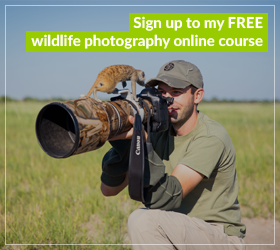I recently spent three days traveling around the Indonesian islands of Komodo and Rinca, photographing the legendary Komodo dragons.
Preparation for the trip commenced several weeks earlier, as I attempted to devise an effective and safe way of getting wide-angle, close-up shots of these notoriously dangerous creatures. I would not have time to set-up camera traps, and I didn’t have enough room to take BeetleCam, so I came up with something a little more basic!
I mounted my camera on top of two wheels (generously donated by my computer chair) and then attached this to a monopod so that I could push the rig up to the dragons. I figured this would give me a 2 meter head-start if one of them decided I looked like lunch! I named my new contraption “KomodoCam”!
Reaching Komodo Island was an epic undertaking… I had to fly to Singapore, then Bali, then the island of Flores, before taking a boat to Komodo Island and Rinca Island. Komodo dragons only live on a few isolated islands in this part of Indonesia.
It is hard to describe the excitement and trepidation I felt as the foreboding volcanic peaks of Komodo Island loomed up in front of me. The island was shrouded in ominous dark clouds and even the sea seemed to have turned black. It really felt like a land lost in time.
My first sighting of a Komodo dragon came shortly after venturing off the boat. I was taken aback by the size of the beast! Komodo dragons can grow up to 3 metres in length and can weigh well over 70kg! This individual was lying in the shade. Being cold-blooded, the dragons are caught in a constant thermal juggling act; in the mornings they must find sunlight in order to warm up, but later in the day they must retreat to the shade before their bodies heat up too much.
Despite their size, the dragons are surprisingly well camouflaged… in fact, they often rely on their camouflage to ambush prey such as wild pigs (below left), deer (below right) and water buffalo. When suitable prey approaches, the dragon will suddenly charge, sometimes at speeds in excess of 20km per hour, and lunge at the throat or underside of the animal. For larger prey such as buffalo, the dragon will deliver a bite that is not aimed to kill immediately. Instead, the saliva of the dragon is like a petri dish of virulent bacteria which rapidly infects the animal, resulting in a protracted and painful death.
Like a snake, the Komodo dragon uses its long, forked tongue to taste the air. Its keen sense of smell allows it to detect a dead or dying animal up to 9km away.
Towards the end of the second day of my trip, an opportunity to use KomodoCam at last presented itself; I came across a large dragon in a flat, open clearing in the forest. I nervously set up the rig and pushed it towards the dragon. The dragon treated the camera with curiosity and obligingly flicked its tongue in and out to investigate the unfamiliar object. To my relief, the beast decided that there was nothing edible and I was spared seeing a Komodo dragon eat my Canon 1Ds mkIII!
In the evening of our last day, thousands of raucous flying foxes emerged from the mangrove swamps and flew overhead, towards the interior of the island. They resembled pterodactyls which seemed like a fitting end to my time in this prehistoric land.
For more pictures of Komodo Dragons (including ones taken by KomodoCam), please look at my Komodo & Rinca gallery. To receive notification when I post pictures from future wildlife photography projects, please sign up to our free newsletter.












This page kept me intrigued and captivated to the end. Thanks for sharing this amazing experience.
Great picture, really admire.
Really awesome snaps… i can see the hardwork you did to capture such perfect moments… nice job.
Very innovative I am looking at my computer chair in a whole different light!
what an idea……….the pics are terrafic…….congretz….luv ur invention
This is beautiful. Seems like one can stroke the one sunbathing. Well done and I wish you some more success on the next trip to where ever and a lot of happy followers on on your site – enjoying what we might not be able to do.